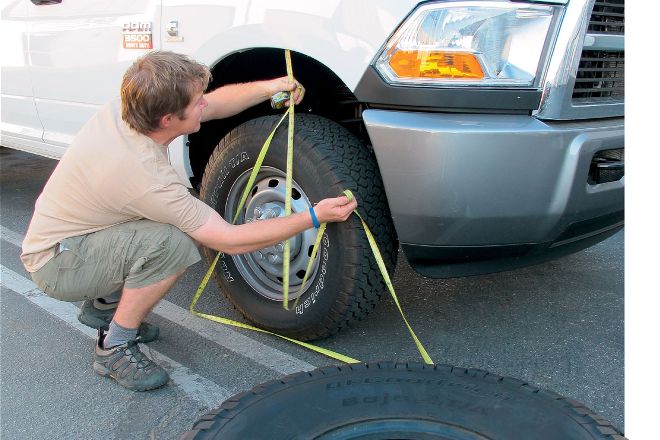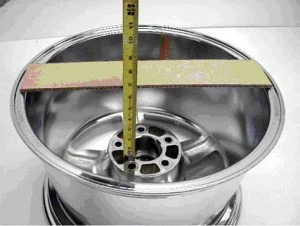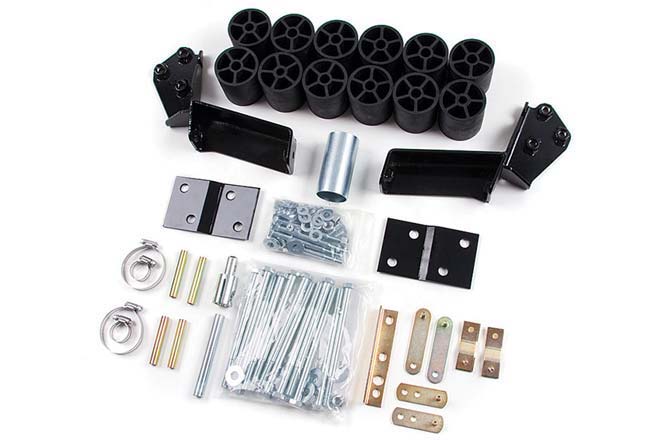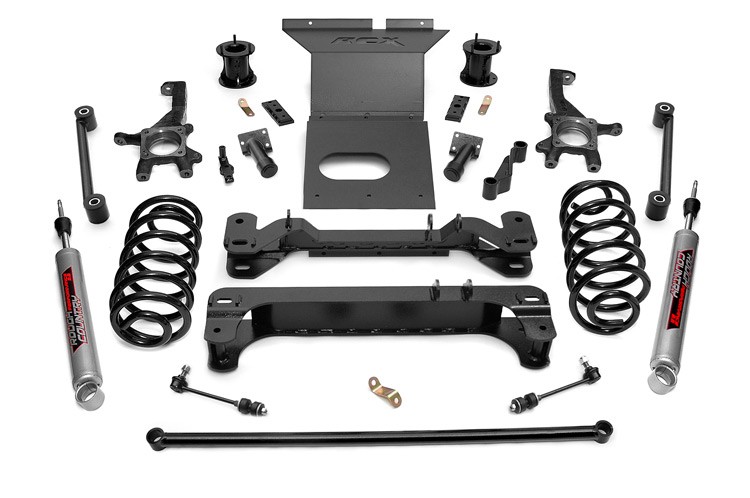You can find the information on the biggest tires to fit on your truck in the owner’s manual. There, the vehicle manufacturer suggests the most suitable sizes of tires (both bigger and smaller) for the car. The two most important factors influencing your final choice are the model of your truck and the size of the rims. On average, if your truck isn’t lifted, you can fit tires up to 33”. In case the vehicle is lifted, you can find a good set of 37” or larger tires to fit.
However, to learn what your truck needs, you have to make some measurements.

How to Measure for the Biggest Tires You Can Fit on Your Truck
To measure for bigger tires, follow these steps:
- Remove the current wheels and measure the tires’ exact width and height. If you plan to get new wheels, measure the backspacing as well.
- Put the wheels back and measure the distance between the tire and every part around it. Include the space between the tire and the bumper, as well as between the tire and the front, back, and top of the wheel well.
- Make the same measurements after turning the front wheels to the full steering lock in all directions. Don’t forget to look at the distance between the tire and suspension components. Also, tire width change may impact the steering components distances, so make sure to measure them as well. All these spaces will help you choose the biggest tires you can fit on your truck.
- Measure the space between the axletube and bumpstop, adding the latter’s length to the final number. Sometimes it may go nearly flat if you try to handle extreme off-road conditions by jumping. So, adding its length will also add a safety margin.
- Drive your truck at an angle to a considerably deep gully or another dip. Such a position will twist the suspension almost to full bump. Now, re-measure the spaces between the tire and close hard parts if the up axle ends appear at full compression due to the suspension flex.
- Turn the wheels left and right and repeat the measurements.
Looking at the measurements you noted, you will get a picture of what your wider or taller off-road tires may hit. This may be a front bumper or a suspension link. While the sheetmetal is expandable and easy to trim to fit your new tires, this might not work with the suspension.
To get the new potential size of the biggest tires you can fit on your truck, look at the overall clearance you have. If the distance from the tire to any hard part is 6”, remember that the suspension will move up 4” before full compression. Thus, you will have about 2” of clearance, and by doubling it, you will get the new size of your tires – 4” larger. However, you may want to go 3” to stay on the safe side.
Measuring Backspacing and Offset
When choosing the biggest tires you can fit on your truck, care to measure the backspacing and offset of your wheels. You may need new wheels to put a larger set of tires on it, and the more the backspacing is, the deeper the wheel will sit. This may make the tire contact the suspension and other parts.
You can measure the backspacing by:
- Removing the wheel.
- Supporting the vehicle with a jack stand.
- Putting the wheel on the ground (better a blanket or a towel to avoid scratches) with the back side up.
- Putting something solid on the edge if the wheel to create a straight edge.

Image source: www.oewheelsllc.com - Measuring the distance between the bottom of the straight edge and the mounting face of the wheel. This is the backspacing.
The offset will be the distance between the mounting face and the centerline of the wheel. If the first is located closer to the back of the wheel, the offset is negative. If it’s closer to the front part, the offset is positive. And if it’s at the center, in one line, then the offset is zero. If you consider the biggest tires you can fit on your truck and you need new wheels, make sure you buy those that have close offset to the original wheels you have/had.
Getting the Biggest Tires You Can Fit on Your Truck: Using a Lift Kit
You can lift your truck by 3” or more using a body lift kit or a suspension lift kit. There are pros and cons to lifting the vehicle, and you should consider them before using a kit.
Body Lift Kit

The kit includes spacers and details to fit them. They are put between the bed and the cab parts of the truck, usually on top of the original bushings. The suspension and other inner parts keep their position and distance from the ground. You may also need to modify your bumpers and extend the steering column shaft to fit the new height. These kits will make it possible to choose the biggest tires to fir on your truck.
The advantages of body lift kits are:
- More intense looks.
- More clearance.
- Ease in installation.
- Price-effectiveness.
- No impact on ride quality.
- No wheel alignment required.
The disadvantages of body lift kits are:
- A gap between the frame and the cab and/or bed of the vehicle.
- Slightly increased center of gravity.
- Exposed trailer hitch.
- Small details in the kit that are easy to lose.
- No considerable improvements in performance.
- Maximum lift is 3”.
Body Lift Kit Cost
Body lift kits may cost from $110 to $600, while some premium kits might be about $800. The installation will cost about $400-$1,200, depending on the kit and the shop.
Suspension Lift Kit

In this case, you get more clearance by spacing down the current suspension or replacing it with a new one. The latter will gave longer coil springs and spacers, taller leaf springs and different supplements for them, lifted control arms, etc.
The advantages of suspension lift kits are:
- Improved looks.
- More clearance.
- More suspension performance in off-road conditions.
- Possibilities to lift the truck higher to get the biggest tires to fit on your truck.
- More choice options, price- and height-wise.
The disadvantages of suspension lift kits are:
- Considerably higher center of gravity.
- The price may be high if you want a competitive kit.
- Ride may become rougher.
Some enthusiasts prefer to install both kits on their vehicles, but it’s not recommended. The truck may become too top-heavy, causing issues that may not be covered by the warranty of the kit manufacturer.
Suspension Lift Kit Cost
Suspension lift kits may cost anywhere from $300 to $2,000. The installation of the kit at a tire shop may cost from $400 to $1,200, depending on the type of the kit you buy. The cost will also depend on the tire shop or dealership you go to.
The Biggest Tires You Can Fit on Your Truck: FAQ
Are Bigger Tires Better?
Depends on what you want from your tires. Wider ones with lower aspect ratio usually provide more handling and performance, but they affect the quality of ride. Usually, a plus-one change (getting tires 1 inch larger) works the best in terms of performance. Every other inch will offer little gains in handling but big losses in comfort.
Do Larger Tires Make a Car Go Faster?
Technically, yes, as larger tires have more distance on them to cover. With every revolution, they travel more than the smaller tires would. You might want to calibrate your speedometer after you get new tires, though. If you find the biggest tires you can fit on your truck and don’t work on the speedo, you may get wrong readings and accidentally go over the speed limit of your area.
How Does Tire and Wheel Size Affect Fuel Economy?
It makes the fuel economy worse, as it adds mass to the vehicle, so more fuel in needed to make it move. Also, larger tires mean more contact patch area, which increases rolling resistance. And the higher it gets, the more fuel the motor uses to break through it. According to the test, 19” and 15” wheels have 1,8 mpg difference in fuel economy (21.1 mpg and 22.9 mpg). However, considering the performance advantages larger tires and wheels offer, this loss isn’t big.
